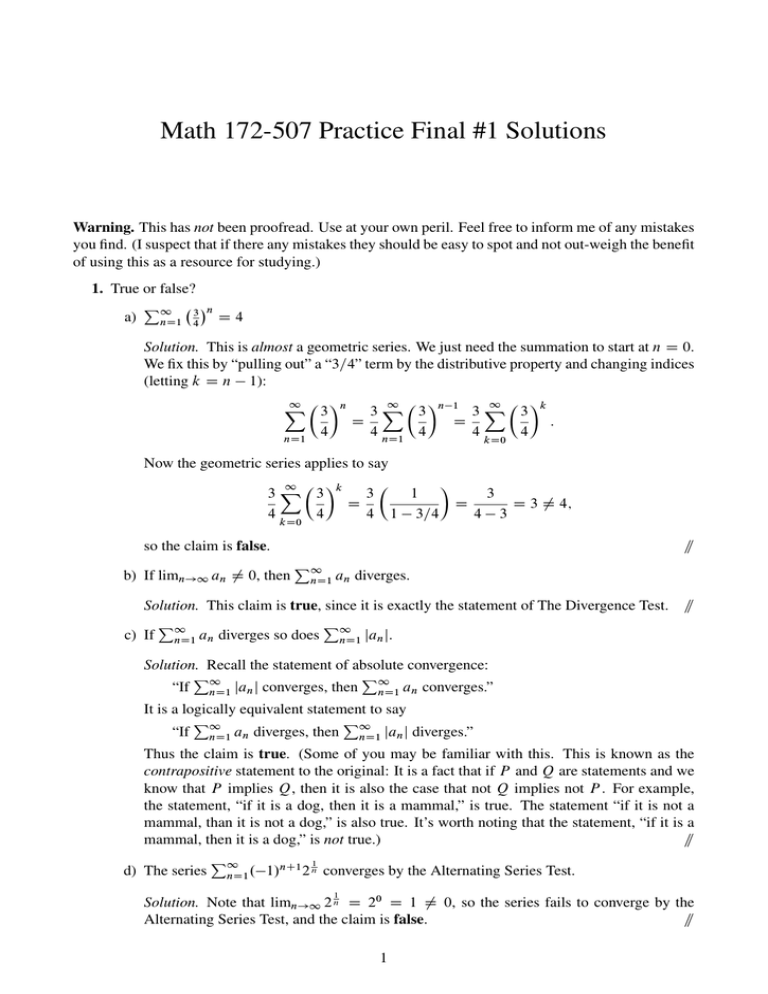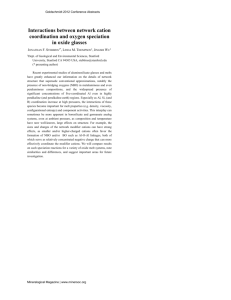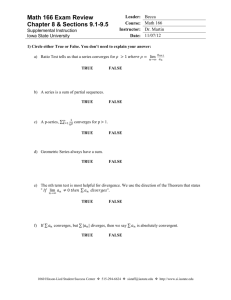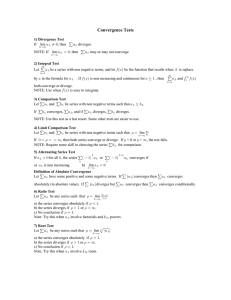Math 172-507 Practice Final #1 Solutions
advertisement

Math 172-507 Practice Final #1 Solutions Warning. This has not been proofread. Use at your own peril. Feel free to inform me of any mistakes you find. (I suspect that if there any mistakes they should be easy to spot and not out-weigh the benefit of using this as a resource for studying.) 1. True or false? P1 3 n D4 a) nD1 4 Solution. This is almost a geometric series. We just need the summation to start at n D 0. We fix this by “pulling out” a “3=4” term by the distributive property and changing indices (letting k D n 1): 1 n 1 1 X 3X 3 n 1 3X 3 k 3 D D : 4 4 nD1 4 4 4 nD1 kD0 Now the geometric series applies to say 1 1 3X 3 k 3 3 D D D 3 ¤ 4; 4 4 4 1 3=4 4 3 kD0 == so the claim is false. b) If limn!1 an ¤ 0, then P1 nD1 an diverges. Solution. This claim is true, since it is exactly the statement of The Divergence Test. == P P1 c) If 1 nD1 an diverges so does nD1 jan j. Solution. Recall the statement of absolute convergence: P P1 “If 1 nD1 jan j converges, then nD1 an converges.” It is a logically equivalent statement to say P P1 “If 1 nD1 an diverges, then nD1 jan j diverges.” Thus the claim is true. (Some of you may be familiar with this. This is known as the contrapositive statement to the original: It is a fact that if P and Q are statements and we know that P implies Q, then it is also the case that not Q implies not P . For example, the statement, “if it is a dog, then it is a mammal,” is true. The statement “if it is not a mammal, than it is not a dog,” is also true. It’s worth noting that the statement, “if it is a mammal, then it is a dog,” is not true.) == P 1 nC1 n d) The series 1 2 converges by the Alternating Series Test. nD1 . 1/ 1 Solution. Note that limn!1 2 n D 20 D 1 ¤ 0, so the series fails to converge by the Alternating Series Test, and the claim is false. == 1 e) If f .x/ D P1 nD1 . 1/nC1 x n , n.nC1/ 1 . 6 then f 00 .0/ D Solution. Since the derivative of the sum is equal to the sum of the derivatives, 1 X . 1/nC1 x n f .x/ D nC1 nD1 1 0 : Differentiating once more gives 00 f .x/ D 1 X . 1/ nC1 n 2 x nD1 D 1 x C 3 2 From the expansion, it’s clear that f 00 .0/ D P1 . 1/n p f) e. nD0 2n nŠ D n 1 nC1 3x 2 C : 5 1=3 ¤ 1=6 so the claim is false. Solution. Recall that the power series expansion for e x is 1 1 X X . 1=2/n . 1/n D De 2n nŠ nŠ nD0 nD0 1=2 xn nD0 nŠ . P1 == So p 1 Dp ¤ e e and the claim is false. P P1 n g) If 1 nD1 cn 3 converges, so does nD1 jcn j. == Solution. True. Think of it like this: limn!1 cn 3n D 0, so cn goes to zero at a rate that’s faster than the rate at which 1=3n goes to zero. This still holds for jcn j. So eventually we will have 1 jcn j n 3 P1 P 1 n for every n. Therefore nD1 jcn j converges by the comparison test with 1 nD1 3 , which converges because it is a geometric series and j1=3j < 1. == R cos x p 2. If f .x/ D 1 1 C t 3 dt find f 0 .x/. Solution. Let u D cos x. Then u Z f .x/ D p 1 C t 3 dt 1 By The Fundamental Theorem of Calculus (part 1) and the chain rule p p f 0 .x/ D u0 1 C u3 D sin x 1 C cos3 x == 3. Let C be the arc y D 12 .e x C e x / 0 x ln 2. Let A denote the area enclosed between C , the x and y axes, and the line x D ln 2. a) Compute A. 2 Solution. Through the standard method (note that 12 .e x C e e x > 0 for all x), ln 2 Z AD 0 1 x .e C e 2 x 1 / dx D 2 x / > 0 for all x because ln 2 Z Z 1 ln 2 x e dx C e dx 2 0 1 1 1 3 1 2 2 Œ e x jln C D : D Œe x jln 0 C 0 D 2 2 2 4 4 x 0 == b) Find the volume generated when A is revolved around the x-axis. Solution. By the standard formula, Z V D 0 ln 2 2 Z 1 x ln 2 2x x .e C e / dx D e C e 2x C 2 dx 2 4 0 ˇln 2 ˇ 1 2x 1 2x 15 15 ln 2 ˇ D e e C 2x ˇ D C 2 ln 2 D C : 4 2 2 4 8 32 2 0 == c) Find the length of the arc C . Solution. Note dy=dx D LD ˇ 0 ln 2 s dy 1C dx ˇ D 1 2 .e x x e 2 dx D ˇ /, so ln 2 r 1C 1 x e 4 e x 2 dx 0 ln 2 r 1 x .e C e 4 x /2 dx 1 D 2 ln 2 Z .e x C e 0 x 3 / dx D A D : 4 0 It is purely coincidence that L D A, but it surely saves a bunch of work. == d) Use Pappus Theorem (or otherwise) to find the y coordinate yN of the centroid of the area A. Solution. Pappus Theorem is as follows: “Let R be a plane region that lies entirely on one side of a line ` in the plane. If R is rotated about `, then the volume of the resulting solid is the product of the area A of R and the distance d traveled by the centroid of R.” C 2 ln 2 . Pappus Theorem then From (a) and (b), we know that A D 3=4 and V D 4 15 8 asserts that 15 3d 15 C 2 ln 2 D and so dD C 2 ln 2 : 4 8 4 3 8 We also know that d D 2 r, where r is the height of the centroid (i.e., the y coordinate). Thus 15 1 15 2 r D C 2 ln 2 ; and we conclude yN D r D C 2 ln 2 : 3 8 6 8 == P n .x p 3/ 4. Find the radius of convergence and the interval of convergence of the series 1 nD1 2n n.nC1/ . 3 Solution. Note, ˇ ˇ p r ˇ ˇ n nC1 2 n.n C 1/ .x 3/ jx 3j jx 3j n ˇ ˇ D lim D ; lim ˇ p ˇ n!1 ˇ 2nC1 .n C 1/.n C 2/ .x 3/n ˇ n!1 2 nC2 2 so the ratio test says that we must have jx 3j=2 < 1 for convergence of the series. Hence jx 3j < 2 and so 1 < x < 5. We must check x D 1 and x D 5 individually. If x D 1, the series becomes 1 X . 1/n ; p n.n C 1/ nD1 which converges by The Alternating Series Test. If x D 5, the series becomes 1 X 1 : p n.n C 1/ nD1 (1) Through the limit comparison test with 1=n, p p n.n C 1/ 1 C 1=n 1=n lim D lim D 1; D lim p n!1 1= n.n C 1/ n!1 n!1 n 1 P 1 so (1) converges if and only if 1 nD1 n converges. But this is the harmonic series, which is known to diverge. Therefore (1) diverges if x D 5. We conclude that the interval of convergence is I D Œ1; 5/. == 5. a) Find the Partial Fraction Decomposition of an D 1 . 4n2 C8nC3 Solution. Consider 4n2 C 8n C 3. We use the “AC method” (the quadratic formula would work as well): 4 3 D 12: What two numbers add to give me 8 and multiply to give me 12? 6 and 2. So 4n2 C 8n C 3 D 4n2 C 2n C 6n C 3 D 2n.2n C 1/ C 3.2n C 1/ D .2n C 1/.2n C 3/ and an D 1 . .2nC1/.2nC3/ Set 1 A B D C .2n C 3/.2n C 3/ 2n C 1 2n C 3 Multiplying both sides by the denominator gives 1 D A.2n C 3/ C B.2n C 1/ D .2A C 2B/n C .3A C B/: Equating coefficients yields the system 2A C 2B D 0; 3A C B D 1: From (2) we see that A D A D 1=2. Therefore B. Using this information in (3) shows B D an D 1 4n C 2 4 1 : 4n C 6 (2) (3) 1=2 and so == b) Show that the partial sum sn of the series telescope.) P1 nD1 an is sn D n . 6nC9 (Hint: Use part a) and Solution. Note an D where bn D 1 4n C 2 1 . 4nC2 sn D n X 1 1 D 4n C 6 4n C 2 1 D bn 4.n C 1/ C 2 So n X ak D bk kD1 bkC1 kD1 D .b1 b2 / C .b2 b3 / C .b3 D b1 bnC1 1 1 n D D : 6 4n C 6 6n C 9 Does the series bnC1 ; P1 nD1 bnC1 / == an converge? If yes, compute its value. If not, explain. Solution. From the previous part, sn D 1 X b4 / C C .bn n . 6nC9 So n 1 1 D lim D : n!1 6n C 9 n!1 6 C 9=n 6 an D lim sn D lim n!1 nD1 == 6. Let f .x/ D 1=x; 1 x 3. Let Pn be the partition of the interval Œ1; 3 into n subintervals of equal length. Let xi denote the left end of the i th subinterval for each i. Finally, let Sn be Riemann sum for f .x/ using partition Pn and the points xi . a) Compute S4 . Also make a graph showing f .x/ as well as the rectangle whose total area is S4 . Solution. The interval width is 2, so the subinterval length is 2=n. Also xi D 1 C for the i th rectangle. If n D 4, then the subinterval length is 1=2 and S4 D f .1/ f .1:5/ f .2/ f .2:5/ 1 1 1 1 77 C C C D C C C D : 2 2 2 2 2 3 4 5 66 We also have this pretty graph: 1 1 1:5 2 2:5 3 5 5 2.i 1/ n == b) Write Sn using the † notation. Solution. From the previous, xi D 1C 2.in 1/ and the subinterval length is 2=n. Therefore Sn D n X n f .xi /x i D1 2X n D n i D1 n C 2i 2 D n X i D1 2 n C 2i 2 : == c) Compute limn!1 Sn . 7. R3 Solution. We know that we should have limn!1 Sn D ln 3 because 1 x1 dx D ln 3, but that is going to be hard to get out of an algebraic series like this. I’m lead to believe that this is some sort of typo, as it’s unreasonable for to expect calculus II students toRdeduce 3 limn!1 Sn D ln 2, unless it is expected that you simply notice limn!1 Sn D 1 x1 dx and compute the integral. (I actually think that this is the main way one would prove that R3 Sn ! 1 x1 dx D ln 3.) == R a) Find a reduction formula for In D x n e x dx: (Hint: Use Integration by Parts.) Solution. We will use Integration by Parts: Z u.x/v 0 .x/dx D u.x/v.x/ Z u0 .x/v.x/dx; where u.x/; v.x/ denotes that u and v are functions of x, not multiplication. Let u D x n and v 0 D e x , so that u0 D nx n 1 and v D e x . Therefore Z Z n x n x In D x e dx D x e C nx n 1 e x D x n e x C nIn 1 == b) Using part a) or otherwise compute I2 D R x2e x dx. Solution. From part a), x2e x C 2I1 D 2 x e x C 2 . xe D x2e x I2 D 8. x 2xe x C I0 / 2e x C C: == 2 a) Find the Taylor polynomial T2 .x/ of degree 2 for the function f .x/ D x 3 at x D 8. Solution. Recall the Taylor polynomial centered at x D a: n X f .n/ .a/ Tn .x/ D nŠ kD0 a/n : .x Let n D 2 and a D 8 so that T2 .x/ D f .8/ C f 0 .8/.x D4C .x 8/ 3 6 .x 8/ C f 00 .8/ .x 2 8/2 : 144 8/2 == b) If T2 is used to approximate .7:5/2=3 estimate the error. Solution. Recall Taylor’s Inequality: “If jf .nC1 .x/j M for jx aj < R, then the remainder Rn .x/ of the Taylor series satisfies the inequality jRn .x/j M jx .n C 1/Š ajnC1 for jx aj < R:” 8 , 27x 7=3 Let n D 2; a D 8; x D 7:5; and choose R D 1. Also, f 000 .x/ D and jf 000 .x/j :0032 for jx 8j < 1. Therefore :0032 j7:5 6 jR2 .7:5/j 9. so f 000 .7/ :0032 8j3 .:0005/.:125/ :0000625: Since T2 .7:5/ D 3:8315972 and .7:5/2=3 3:83154716, so the actual remainder is jT2 .7:5/ .7:5/2=3 j :00005004. Not a bad estimate. == R1 2 a) Show that the improper integral 0 xe x dx converges and compute its value. Solution. Z 1 xe x2 1h e 2 dx D 0 b) Does the series P1 nD1 ne n2 ˇ1 ˇ D x2 ˇ 0 1 lim e 2 x!1 x2 1 .0 2 1 D 1 1/ D : 2 == converge? Justify your answer. Solution. Consider f .x/ D xe x2 . Recall The Integral Test: “Suppose f is continuous, P1 positive, decreasing function on Œ1; 1/ and let an D f .n/. Then the series nD1 an is convergent if and only if the improper integral R1 1 f .x/dx is convergent.” 2 On Œ1; 1/, xe x is clearly positive and continuous. We want to show that f .x/ is decreasing, so set 2 2 2 f 0 .x/ D e x 2x 2 e x D e x .1 2x 2 / < 0: 2 e x > 0 for all x, we only need to find when 1 solving the inequality 1 2x 2 < 0: 2x 2 is negative. This is equivalent to 1 1 < x2 ) < x: 2 4 So .1=4; 1/, and hence decreasing on Œ1; 1/. Part a) P shows that R 1f .x/x 2is decreasing onR 1 x2 n2 converges, so 1 xe converges and The Integral Test asserts that 1 nD1 ne 0 xe converges. == P n2 c) If the partial s5 is used to approximate s D 1 , give an estimate for js sn j. nD1 ne 2x 2 < 0 1 1 < 2x 2 ) ) Solution. Recall the Remainder Estimate for The Integral Test: “If †an converges by The Integral Test and Rn D s sn , then Z 1 Z 1 f .x/dx Rn f .x/dx:” nC1 Applying this gives Z 1 2 xe x dx D R5 5 1h e 2 n ˇ1 x2 ˇ ˇ 5 D 7 1 lim e 2 x!1 x2 e 52 1 D e 2 25 6:94: ==





